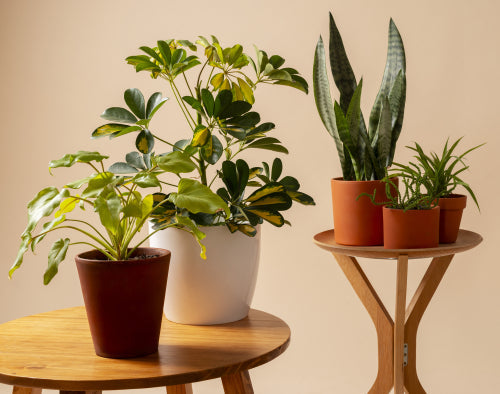Sustainability is at the forefront of nearly every industry, including gardening. People are increasingly becoming aware of the environmental impact of their choices, from the materials they use to the products they purchase. One of the simplest ways to embrace sustainability in your everyday life is by opting for eco-friendly planters. But can you have an eco-conscious garden that also looks stylish and modern? The answer is a resounding yes!
This guide will delve into the world of eco-friendly planters, providing you with insights into the best materials, creative design ideas, and practical tips on how to make your gardening practices more sustainable while maintaining a chic and trendy aesthetic.
1. Why Choose Eco-Friendly Planters?
Before diving into the options and tips, it's important to understand why eco-friendly planters matter. Traditional gardening materials, such as plastic and metal, contribute to environmental degradation. Plastic, in particular, takes hundreds of years to decompose and is often not recyclable, leading to massive waste.
Eco-friendly planters, on the other hand, are designed to be sustainable, using materials that are biodegradable, recyclable, or repurposed. This not only helps reduce waste but also ensures that your gardening practices are contributing positively to the environment rather than harming it.
Choosing eco-friendly options also promotes a healthier, toxin-free environment for your plants, as many non-organic materials can leach harmful chemicals into the soil. When you choose the right planters, you are creating a more natural, green space for your plants to thrive in. Plus, these planters often boast unique, stylish designs that blend seamlessly with modern home decor.
2. Eco-Friendly Planter Materials
The material you choose for your planters plays a crucial role in how sustainable your garden will be. Let's explore some of the most popular eco-conscious materials that combine sustainability with style:
a. Recycled Plastic and Upcycled Materials
Recycled plastic planters are made from post-consumer plastic waste, such as water bottles, plastic bags, or discarded packaging. These planters reduce the need for new plastic production and help divert waste from landfills. Many of these planters have a sleek, modern look and are durable enough to withstand the elements, making them perfect for both indoor and outdoor use.
Upcycled materials, such as reclaimed wood, old metal cans, and repurposed fabric, can also be transformed into unique planters. For instance, you can create beautiful hanging planters from old mason jars or tin cans. Not only are you helping the planet by reusing materials, but you're also adding a creative, personal touch to your gardening space.
b. Bamboo Planters
Bamboo is one of the most sustainable material available. It grows quickly, requires minimal resources to cultivate, and is biodegradable. Bamboo planters offer a natural aesthetic and blend seamlessly with both rustic and modern garden designs. You can find bamboo planters in various shapes, from sleek cylindrical pots to charming basket-like designs.
These planters are also lightweight, making them easy to move around, and they have the ability to retain moisture, which benefits the plants growing within. Bamboo is naturally resistant to pests and fungi, further enhancing its sustainability.
c. Coconut Shell Planters
Coconut shells, often discarded as waste after the coconut's flesh is harvested, are being increasingly repurposed into eco-friendly planters. These planters are lightweight, durable, and biodegradable, making them a perfect option for sustainable gardening. Their natural texture and earthy tones give them a tropical feel, and they work especially well for plants like succulents, herbs, or small indoor flowers.
The best part about coconut shell planters is that they are often handmade, meaning you can find unique pieces that add a personal touch to your space.
d. Clay and Terracotta Planters
While traditional terracotta planters are made from clay, they are often sourced in ways that can be harmful to the environment. However, some eco-conscious brands now focus on using sustainable clay sources and eco-friendly manufacturing processes. Terracotta is naturally porous, making it ideal for plants that require good drainage, such as succulents and cacti.
If you opt for clay planters, be sure to choose those made with sustainable practices or consider purchasing from second-hand or antique stores to reduce the demand for new production.
e. Compostable Pots
Compostable planters are made from plant-based materials like cornstarch, rice husks, or even paper. These planters break down over time and can be directly planted into the ground or composted after use. They are an excellent option for those who want a zero-waste approach to gardening.
Compostable pots come in a variety of designs, including biodegradable seed starter pots, which are ideal for growing seedlings indoors before transferring them into the garden.
3. Creative Design Ideas for Eco-Friendly Planters
Now that we've explored the materials, let's dive into creative design ideas for making your eco-friendly planters not only sustainable but stylish too. Here are a few ways you can incorporate eco-conscious planters into your home or garden:
a. Hanging Gardens
Utilize vertical space by creating a hanging garden with upcycled or bamboo planters. Suspended from walls, railings, or ceilings, these planters can add a modern touch to your indoor or outdoor spaces. You can hang planters made from mason jars, coconut shells, or recycled plastic bottles for a minimalist, eco-friendly aesthetic.
b. Repurposed Furniture Planters
Why throw out that old dresser or wooden crate when you can transform it into a gorgeous planter? Repurposed furniture such as wooden drawers, old bookshelves, or even a ladder can be turned into vertical planters. Fill each compartment with an assortment of plants for a colorful, eye-catching display that makes use of discarded furniture.
c. Terracotta Pot Stacking
For a quirky, artistic look, stack terracotta or bamboo pots of various sizes to create an attractive feature in your garden or on your balcony. You can arrange the pots at different angles or use them as a tower, planting a variety of plants in each one. This approach is especially useful for small spaces, as it takes advantage of vertical gardening.
d. Concrete Planters with a Twist
Concrete planters are often seen as heavy and industrial, but when combined with eco-conscious elements such as organic shapes or bright colors, they can become a stylish addition to any modern home. You can create a DIY concrete planter by mixing your own concrete and using recycled materials like old plastic bottles for molding.
e. Planting in Natural Fibers
Natural fibers like jute, hemp, or burlap can be used to make plant covers or baskets that complement eco-friendly planters. These rustic designs are perfect for those who love the bohemian aesthetic while still caring for the environment. You can even weave your own planters for a unique and personal touch.
4. Practical Tips for Environmentally Friendly Planting
Beyond choosing the right planters, there are other steps you can take to ensure your gardening practices are as eco-friendly as possible:
a. Use Organic Soil and Fertilizers
Opt for organic compost and fertilizers that are free from harmful chemicals. These products not only improve the health of your plants but also enrich the soil without polluting the environment.
b. Opt for Native Plants
Native plants are adapted to your region's climate and require less water, fewer pesticides, and minimal maintenance. By planting species native to your area, you help promote local biodiversity while conserving water and reducing the need for chemical treatments.
c. Repurpose Household Waste for Plant Nutrition
Rather than throwing away food scraps, consider composting them for your garden. Kitchen scraps like coffee grounds, banana peels, and egg shells can be composted into nutrient-rich soil, making it an eco-friendly alternative to store-bought fertilizers.
Sustainable Gardening Starts with Eco-Friendly Planters
Eco-friendly planters are not just about being kind to the environment; they are also about creating a space that reflects your personal style while promoting sustainability. From recycled plastic to bamboo and coconut shell planters, there are endless options to choose from that align with both your environmental values and aesthetic preferences. By incorporating these eco-conscious choices into your garden, you are not only fostering a healthier planet but also nurturing a greener, more sustainable lifestyle.
So, whether you're an experienced gardener or just starting out, make sure your next planting project focuses on eco-friendly planters. Not only will your plants thrive, but you'll also contribute to a more sustainable future, one planter at a time.
You may also be interested in: Klatt Objects - stilvolles Design - DerGartenmarkt.de ...
Discover your gardening joy with a top selection. Your joy and green happiness begin here. Shop Now
Powered by flareAI.

